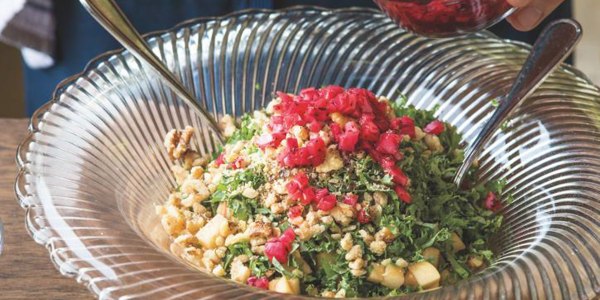Yom Kippur is the holiest day of the Jewish Year, a day that for many Jews is centered on prayer, reflection, quiet meditation and, unlike most Jewish festivals, fasting. On Yom Kippur, Jewish people do not eat or drink for 25 hours and then typically break the fast after sundown with a big spread of cold dishes, since the day is meant to be spent on assessing one’s life, not cooking. In many homes this means platters of bagels, cream cheese, smoked fish, chopped liver and a variety of salads.

Thanks to the new cookbook, Zahav: A World of Israeli Cooking by James Beard Award Winning Chef Michael Solomonov, it’s easy to create a Break Fast menu that will put your typical bagel and cream cheese spread to shame. His new book is a gorgeous collection of the recipes that capture his acclaimed style of cooking— recipes for a dizzying array of delicious salatim, mezze, kebabs, rice and desserts that marry the soulful, vibrant flavors of North Africa, the Middle East and the Mediterranean.
7 tabbouleh recipes: Bulgur, quinoa, spicy and more spins on the grain salad
But the book is more than just a collection of great recipes; it also a very personal memoir in which Solomonov shares his family’s tragedy. In 2003, Solomonov’s younger brother, David, had just completed his final month of service in the Israeli Defense Forces when he volunteered to cover a shift on Yom Kippur for a more religious comrade. He was holed up behind a boulder in an apple orchard in Metullah overlooking Lebanon where he was shot and killed by three Hezbollah snipers. He was 21 years old.
His brother’s death took an obvious toll on Solomonov, but cooking became a way to keep his brother with him:
“My brother had died fighting for Israel and nothing I could do would change that,” he writes in his cookbook. “But for the first time. I began to see cooking as a powerful way to honor David’s memory. I could expose people to a side of Israel that had nothing to do with politics and didn’t ever make the evening news...the bright vegetable salads, plate after plate of intensely-flavored mezze, and skewers of kebabs and shishlik grilled over live charcoal. It was all delicious and soulful. Someone had to translate all of this food the American palate, and I knew that it should be me.”
Many of the recipes in Solomonov’s book, in particular the mezze and salatim, would make the perfect Break Fast meal because they can easily be prepared in advance and can be served at room temperature right after the fast is over; no need to wait for anything to heat up. Our spread includes Kale, Apple, Walnut and Sumac Onion Tabbouleh, and Beets with Tehina. Add some Challah and good company.
Beet salads are frequently paired with something acidic to cut through the sweetness of the vegetable: goat cheese, yogurt, or a bright, citrusy vinaigrette. This recipe takes a different approach, using the slight bitterness of tehina to tame the sugar and heighten the earthiness of the beets. The combination is magical, capable of casting a spell on people who normally don't like beets. This beet salad is one of a handful of dishes that have been on the Zahav menu every day since we opened—we should post a sign that says, "Over half a million served."
The simple tehina sauce is one of my basic building blocks and is so versatile that once you master it, there are a million things you can do with it. The important step here is to allow the garlic and lemon juice to hang out for ten minutes after blending but before adding the jarred tehina. This step helps stabilize the garlic and prevents it from fermenting and turning sour and aggressive, which is the problem with a lot of tehina sauces (and therefore the hummus made from them).
Because you're making an emulsion (oil-based tehina incorporated into water and lemon juice), the tehina sauce can sometimes separate or seize up. Don't panic! Keep a glass of ice water nearby and add a few tablespoons at a time to the lemon juice-tehina mixture while you're whisking, until your creamy emulsion returns.
Excerpted from Zahav: A World of Israeli Cooking, © 2015 by Michael Solomonov and Steven Cook. Reproduced by permission of Houghton Mifflin Harcourt. All rights reserved.

